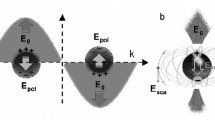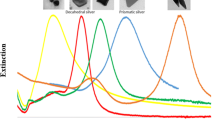Abstract—
Measurements of optical parameters of media by surface plasmon spectroscopy have a number of advantages: possibility of real-time monitoring, label-free operation, accuracy, and high sensitivity. In addition, surface plasmon spectroscopy is a universal method, used in sensor applications (e.g., biosensors and sensors for volatiles and solutes). This method is especially efficient for detecting trace amounts of materials in gas and liquid media. Its sensitivity is sufficient for measuring the refractive index of a medium with an error of 10–6. Using nanostructured surfaces, one can improve sensitivity to 10–9. In this study, we expanded the possibilities of plasmon spectroscopy (which made it possible to measure impurity concentrations as low as 10–13 mol/L) and described the mechanisms and dynamics of modification of metal–aqueous solution interface (electrical double layer (EDL)). The measurement results for phthalocyanine solutions with concentrations of 10–9 and 10–13 mol/L are reported.



Similar content being viewed by others
REFERENCES
P. Smichowski and D. Gómez, “Spectroscopic and chromatographic techniques and methodologies for the determination of metals, metalloids and ions in atmospheric aerosols,” Compr. Anal. Chem. 70, 239–266 (2015). https://doi.org/10.1016/bs.coac.2015.09.007
S. Ahuja, “Lesson learned from water disasters of the world,” Sep. Sci. Technol. 11, 417–427 (2019). https://doi.org/10.1016/B978-0-12-815730-5.00016-8
A. Sanz-Medel, J. M. Costa-Fernández, and R. Pereiro, “Atomic Spectrometry,” in Reference Module in Chemistry, Molecular Sciences, and Chemical Engineering (Elsevier, Oxford, 2013). https://doi.org/10.1016/B978-0-12-409547-2.05348-8
J.-M. Mermet, “Calibration in atomic spectrometry: A tutorial review dealing with quality criteria, weighting procedures and possible curvatures,” Spectrochim. Acta B.65, 509–523 (2010). https://doi.org/10.1016/j.sab.2010.05.007
T. S. West, “The determination of very small amounts of materials by the techniques of atomic-absorption and atomic-fluorescence spectroscopy,” Pure Appl. Chem. 26 (1), 47–64 (1971). https://doi.org/10.1351/pac197126010047
A. Taylor, “Atomic spectroscopy, biomedical application,” in Encyclopedia of Spectroscopy and Spectrometry, Ed. by J. C. Lindon, G. E. Tranter, and D. W. Koppenaal, 3rd ed. (Elsevier, Amsterdam, 2017). Vol. 1, pp. 76–80. https://doi.org/10.1016/B978-0-12-409547-2.04972-6
I. A. Abronin, K. Ya. Burshtein, and G. M. Zhidomirov, “Quantum-chemical calculations of solvent effects on the electronic structure and reactivity of molecules,” J. Struct. Chem. 21 (2), 236–255 (1980). https://doi.org/10.1007/BF00746890
M. Kononov, V. Pustovoy, and V. Svetikov, “Investigation of dynamics of plasmon resonance conditions at the interface of an aqueous solution of copper phthalocyanine – Ag film,” in Book of Abstracts of the International Conference “Advanced Laser Technologies” (September 15–20,2019, Prague, Czech Republic), pp. 254–255. https://doi.org/10.24411/9999-011A-2019-00206
S. V. Vinogradov, M. A. Kononov, V. I. Pustovoi, and V. V. Svetikov, “Plasmonic spectroscopy of the water solutions of the copper phthalocyanine adsorbed on a silver surface,” Prikl. Fiz. No.1, 69–73 (2018) [in Russian].
S. I. Valyanskii, V. V. Savranskii, M. A. Kononov, and S. V. Vinogradov, “A simple optical method for determination of buffer layer quality,” Bull. Lebedev Phys. Inst. No. 2, 3–9 (2003).
Surface Polaritons – Electromagnetic Waves at Surfaces and Interfaces, Ed. by V. M. Agranovich and D. L. Mills (North-Holland Publ., Amsterdam, 1982). Vol. 1.
W. Schmickler, Electrical Double Layers: Theory and Simulations (Wiley, 2007). https://doi.org/10.1002/9783527610426.bard010202
Yu. Petrov, V. V. Svetikov, and S. P. Surov, “Surface electromagnetic waves at the electrode-electrolyte interface,” Laser Phys. 2, 1028–1031 (1992).
S. V. Vinogradov, M. A. Kononov, V. M. Kononov, V. V. Savransky, and V. V. Tishkov, “Thin film growth control and manage system for glass prism preparation for surface plasmon applications,” Prikl. Fiz. No.4, 5–9 (2017) [in Russian].
Author information
Authors and Affiliations
Corresponding author
Additional information
Translated by Yu. Sin’kov
About this article
Cite this article
Kononov, M.A., Pustovoy, V.I. & Svetikov, V.V. Specific Features of the Excitation of Surface Plasmons at the Interface between Metal and Aqueous Solution of Extremely Low Concentration. Phys. Wave Phen. 28, 94–97 (2020). https://doi.org/10.3103/S1541308X20020089
Received:
Revised:
Accepted:
Published:
Issue Date:
DOI: https://doi.org/10.3103/S1541308X20020089




